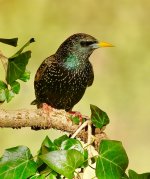In my last post, I indicated that I would explain more about how I use flash for my garden bird photography.
First of all, I need to explain why I choose to use flash instead of available light.
My camera, a Canon 60D is not very good when used at high ISO settings. Anything above 400 tends to produce some noise, which is even more noticeable if I have to crop the photo. I use my iPad for editing and do not have a noise filter. I want to be able to take photos in any lighting conditions - even in the rain.
Small garden birds move quickly and are small in the viewfinder, meaning that to obtain decent sized images I have to zoom in, meaning that they are then optically close to the camera. This results in any movement across the frame being greatly exaggerated. To obtain sharp images of these birds I need to have a high shutter speed.
This has been my main concern. How to obtain a really fast shutter speed whilst keeping the ISO low. What is more, I need to keep the aperture as small as possible (large number) as the depth of field is very small so close to the camera. I really need about F11.
So, I looked at using flash. It sounded simple at first. Flash gives a short, intense burst of light.
Or does it?
A normal flash unit gives a burst of light of about 1/300 of a second. That is not that fast. What is more, the camera has to be set at the flash synchronisation speed or lower, which for my camera is 1/250 of a second.
I did some research on the Internet. How could I get a faster flash speed without buying very expensive kit.
I then found out that you can obtain a higher flash speed simply by cutting the power! If you halve the power of a unit, you more or less double the speed, as the flash gives the same amount of light for half the time. By the time you get to 1/16th power, the speed is 1/6200 of a second for my Canon flash.
This seemed like the answer. I might need to buy more flash units to make up for the low power settings and move them closer to the perch, but I should be able to get my fast shutter speeds at last. In fact, I discovered that it is this method that is used to get those stunning photos of humming birds in flight.
But I hit more problems. Big problems.
More about those problems and how I had to completely rethink my approach in my next post.
Until then, I will finish this long and perhaps boring post with another of my friends, shot with the system I finally settled on.
First of all, I need to explain why I choose to use flash instead of available light.
My camera, a Canon 60D is not very good when used at high ISO settings. Anything above 400 tends to produce some noise, which is even more noticeable if I have to crop the photo. I use my iPad for editing and do not have a noise filter. I want to be able to take photos in any lighting conditions - even in the rain.
Small garden birds move quickly and are small in the viewfinder, meaning that to obtain decent sized images I have to zoom in, meaning that they are then optically close to the camera. This results in any movement across the frame being greatly exaggerated. To obtain sharp images of these birds I need to have a high shutter speed.
This has been my main concern. How to obtain a really fast shutter speed whilst keeping the ISO low. What is more, I need to keep the aperture as small as possible (large number) as the depth of field is very small so close to the camera. I really need about F11.
So, I looked at using flash. It sounded simple at first. Flash gives a short, intense burst of light.
Or does it?
A normal flash unit gives a burst of light of about 1/300 of a second. That is not that fast. What is more, the camera has to be set at the flash synchronisation speed or lower, which for my camera is 1/250 of a second.
I did some research on the Internet. How could I get a faster flash speed without buying very expensive kit.
I then found out that you can obtain a higher flash speed simply by cutting the power! If you halve the power of a unit, you more or less double the speed, as the flash gives the same amount of light for half the time. By the time you get to 1/16th power, the speed is 1/6200 of a second for my Canon flash.
This seemed like the answer. I might need to buy more flash units to make up for the low power settings and move them closer to the perch, but I should be able to get my fast shutter speeds at last. In fact, I discovered that it is this method that is used to get those stunning photos of humming birds in flight.
But I hit more problems. Big problems.
More about those problems and how I had to completely rethink my approach in my next post.
Until then, I will finish this long and perhaps boring post with another of my friends, shot with the system I finally settled on.





